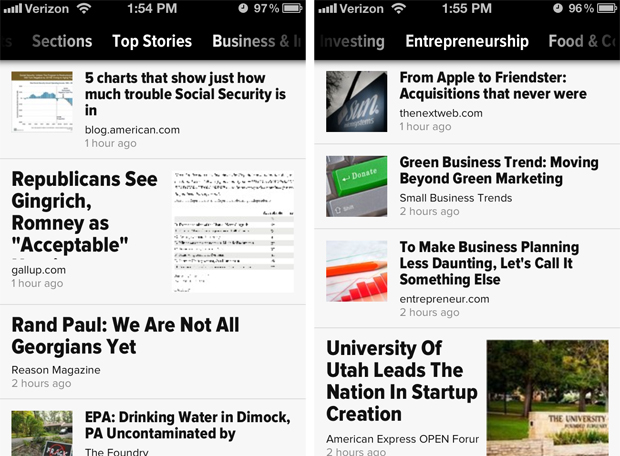
On the heels of social newsreader FlipBoard launching an iPhone app, personalized e-magazine Zite today expands from the iPad to the iPhone, too. The move by the nine-month-old startup, which CNN acquired in September for $20 million, demonstrates just how much competition and overlap there is in the highly competitive aggregation space.
"We're all news aggregators, but we all have very different philosophies," says Mark Johnson, CEO of Zite, before ticking off a slew of competitors. "I mean, look at AOL Editions, which is delivered once a day in this magazine format. There's Pulse, which is an RSS reader. There's FlipBoard, which is a social reader. There are all these different ways of delivering news--it's kind of nice to see all this happening at once."
But, he adds, "I mean, only two or three of us are going to survive."
Zite's push to the iPhone is a play at boosting user engagement. As an iPad app, usage was limited to times when such a larger device could be used--mostly on nights and weekends, according to Johnson. On the iPhone, "I expect usage to be more frequent, but with less time spent on the device--say if you're at a bus stop, or have five minutes at Starbucks," he says. "I expect usage to start to flatten out a bit--for people to start using it a lot during the day."
[twistage 7caf81becda10]
The Zite iPhone app ports over all the best features of the iPad version. The app (see video below) is essentially split into two sections: a rotator wheel on top displaying all your personalized news sections (top stories, business, technology, and so forth), with news stories displayed below in a scrollable column of items. "The challenge here is designing elegantly for a small screen--we tried to transfer all the features over but do it in a way that you can flick through with one thumb, instead of having to maneuver with your whole hand," Johnson says.

From my experience, the app is very fast and scrolls smoothly, especially when loading thumbnails. However, similar to on the iPad, Zite's iPhone app doesn't have the same pizzazz and sexiness of FlipBoard's flap-folding design. (One issue with both services: They're cloud-based, meaning they're not exactly the best apps when it comes to use on the subway. Johnson says they're looking into an offline reading mode.)
Still, Zite's bread and butter has never been its design aesthetic--it's always been its personalization. And the more engagement Zite sees from iPads and iPhones, the more personalized it can become. "We can start to gather some great data, and really figure out how to ramp up personalization," Johnson says. "It's probably true that you want slightly different news on your iPhone than you do on your iPad--we can deliver that kind of stuff because we have this really strong platform to build on."
The company is now focused on more mobile expansion. Johnson says the team aims to release a Zite app for every major mobile device within the next 12 months, a product cycle that will likely garner the service lots more users and lots more data.
And potentially lots more brand advertisers. The startup has no interest in integrating traditional ads into the service, but it is experimenting with ways to incorporate brands while not disrupting the user experience. "We want to deliver highly personalized news--we don't want to start putting non-personalized ads in the product," Johnson says. Instead the company has started testing out various brand channels, such as the one the company launched recently with fashion brand Lululemon. The idea is to get users to opt in to the channels, which would deliver personalized content based on your interests, similar to following a brand on Twitter--only more tailored to your tastes. So in this case, Lululemon's channel would deliver content related to yoga, running, or fitness. Users wouldn't follow the brand channel--or even have it suggested to them--unless they were already interested in that type of content.
"It's not to sell things," says Johnson. "It's for the brand that wants to get in front of users and foster a deeper relationship than just serving up ads. They've got blogs and Twitter accounts, but they haven't really figured out how to disseminate this content. We've got a great platform, with [potential] channel sponsorships or content that you could sponsor within a channel, and get some distribution to a highly targeted audience."
Ultimately, that platform is enabled by all the data Zite collects to personalize each user's experience--data that will continue to pour in the more mobile devices the app expands to. But the startup is still a far way off from introducing any of this on a larger scale--it's just an experiment for now, Johnson clarifies.
Oh, and what about CNN, the news organization that acquired Zite a couple months ago? Johnson says CNN has no interest in fiddling with the algorithm and messing up Zite's user experience. ("If you prefer Fox News, we'll give you Fox News," he says.) Eventually, Zite's technology and algorithm will help personalize CNN.com for its readers, but for now, Zite is just focused on Zite.
"They don't want to distract us too much right now--it's not like we're going to move the company to Atlanta," Johnson says. "We're sort of like CNN labs on the west coast."
[Top Image: Flickr User Zandwacht]